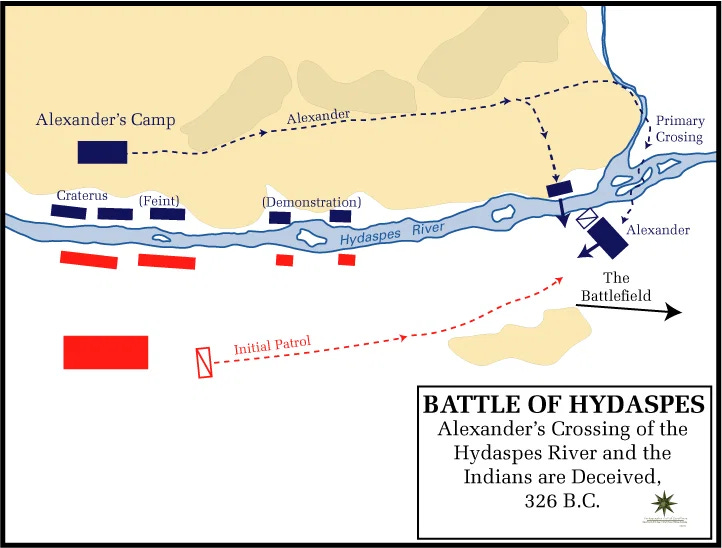Battle Report: Battle of Hydaspes (326 B.C.E)
The Battle of Hydaspes was one of the final battles in Alexander’s great campaign to conquer “Ancient Asia”, which at the time was Persia, Bactria, and Western India. Much of the which was new to the Greek world at the time, the battle itself took place on the banks of the Jhelum River in the Punjab region of the Indian subcontinent. This being the deepest into Asia any non-Asiatic person had been at that point, everything that Alexander’s Army saw was a culture shock to them.
Following his conquering of Persia, Alexander wanted to probe the remaining kingdoms of western India to test their strength for a future campaign. King Porus of Paurava blocked Alexander’s advance at Hydaspes (now Jhelum) using a ford as a separation between both armies. Numerically the armies held similar sizes, but Alexander fielded more cavalry and Porus 200 war elephants (the size of which had never seen by Greeks).
The positions before the Battle of Hydaspes, 320 BCE. In blue are the forces of Alexander the Great whilst in red are those of King Porus.
To defeat this blockage, Alexander separated his forces into two groups. The first on the left was a smaller contingent at the initial ford that he led and the second was by Craterus (one of his more capable generals) who took the larger force to a ford 17 miles away. After seeing that the larger force had crossed the river; Porus set his army for attack with cavalry on the flanks, infantry in the center, and elephants in the front. Alexander set his heavy infantry into a phalanx at the center, both flanks with cavalry (him leading the right and sending his general Coenus on a wide left flank behind a hill).
The charge of the elephants almost broke the Macedonian Phalanx but they held till the Indian Infantry joined the fray. Alexander attacked the right flank but failed to find an exploitable gap with his cavalry. Eventually, Coenus returned to the battlefield at the rear of the Indian formation, thus Alexander’s army was able to defeat the Indian cavalry and encircle the infantry. Porus seeing no other option reformed his infantry into a defensive block and offered to surrender if granted terms.
The victory of Alexander the Great over the Indian prince Porus at the Battle of the Hydaspes, 326 BCE; from The Battle Between Alexander and Porus, oil on canvas by Nicolaes Pietersz Berchem.
Alexander allowed Porus to remain king of Paurava but imposed a steep tribute against him as a Satrapy of Macedonia. The battle itself led to Alexander’s generals questioning his reasoning for such campaigning after such an “unnecessary” battle. They would be on the verge of mutiny till Alexander agreed to return to Greece. On his return though, Alexander was believed to be poisoned without a strong heir, leading to his empire becoming divided among his generals into several smaller kingdoms/empires.
Fontebasso, Francesco (1709-69) Primary creator: Italian Nationality: Musee des Pays de L'Ain, Bourg-en-Bresse, France Location: Giraudon Credit: oil on canvas Medium: defeated Porus at the Battle of Hydaspes in 320 BCE.






